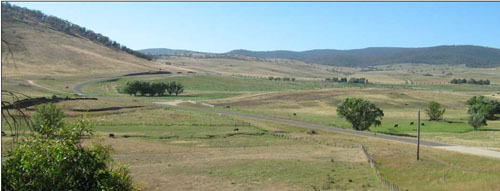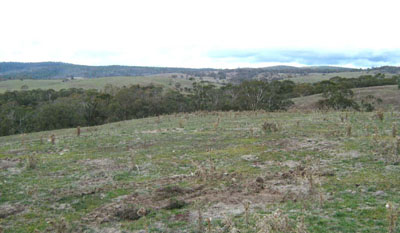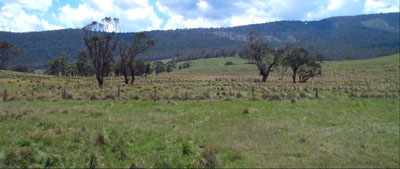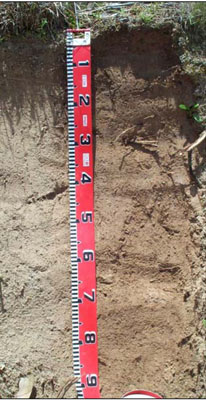Cobungra (Symbol: Cn)
EG212 | EG110
Geology
Palaeozoic granite and related metamorphic rocks.
Landform
Enclosed rolling low hills and broad valleys, mostly above 900 m.
The Cobungra map unit may be subdivided into three components. Rounded low hills are the most extensive component and these may or may not have rock outcrops. Rounded low hills without rock outcrop are the most extensive component. Areas comprising broad drainage lines and rounded low hills with rock outcrop are less extensive.

Cobungra map unit near Cobungra on the Omeo to Hotham Road. The Bloomfield map unit is in the middle-ground on the left.
| Original vegetation Montane grassy woodland and herb rich woodland. Soils Component 1: Soils on rounded low hills without rock outcrop These soils form the majority of soils around Cobungra and the eastern area around Limestone Road. The soils generally have deep brown or greyish brown sandy loam surfaces with a paler coloured sub-surface. Generally these overlie sandy clay loam to sandy clay subsoils with red colour predominating. Areas mapped as Cobungra west of Omeo appear to have shallower surface soils and more clayey subsoils. This is probably due to the lower quartz content in the parent rock. Two soil pits were excavated on this mapping unit (EG 110, and EG 212). Component 2: Soils in the broad drainage lines No pits were sampled within the drainage lines. However a shallow pit on the flood plain of Morass Creek near Limestone Road has been described (Geo. Ref. 0582612E 5915934N). The surface soils are dark grey sandy loams, high in organic matter. Weakly structured dark grey fine sandy clay loams to clays continue to at least 70 cm. These soils are poorly drained both externally and prone to waterlogging. Component 3: Soils on rounded low hills with rock outcrop Both the areas around Limestone Road and Cobungra have areas of granite outcrop. No pits have been excavated within these areas. Land use The land has been mostly cleared and used for grazing. |  |
Site EG212
| Location: Limestone Road | Geo. Ref. 0582185E 5915410N |
| Australian soil classification: Bleached, Eutrophic, Red KANDOSOL | Red gradational soil (red earth) |
| General landscape description: Rounded low hills | |
| Geology: Palaeozoic granite | |
| Site Description: Upper north facing slope (5% slope) | |
| Land use: Grazing on annual pasture | |
| Original vegetation: Montane grassy woodland and herb rich woodland | |
| Mapping unit: Cobungra (Component 1) |

Soil profile morphology
| Surface soil |  | ||
| A1 | 0 – 15 cm | Dark brown (10YR4/3); coarsesandy loam; weak medium (10 – 20 mm) granular structure; very weak consistence dry; clear change to: | |
| A21 | 15 – 35 cm | Light brown (7.5YR6/4), conspicuously beached (7.5YR7/2d); coarse sandy loam; apedal; very weak consistence dry; diffuse change to: | |
| A22 | 35 – 60 cm | Brown (7.5YR5/4); coarse sandy loam; apedal; weak consistence dry; clear change to: | |
| Subsoil | |||
| B21 | 60 – 100 cm | Yellowish red (5YR5/6); sandy clay loam; apedal; firm consistence dry; diffuse change to: | |
| B22 | 100 – 110 cm | Yellowish red (5YR5/6) with white flecks of feldspar; clayey sand; apedal; firm consistence dry |
Key profile features
- Lack of a marked texture contrast between the surface (A) horizon and the subsoil (B) horizon.
- The sandy and hard setting nature of the soil profile.
| pH | Salinity rating | Sodicity | Dispersion | Slaking | |
| Surface soil (A1 horizon) | Strongly acid | Very low | Non sodic | None | Water stable |
| Subsurface soil (A21 horizon) | Strongly acid | Very low | Non sodic | Slight | Slakes partially |
| Deeper subsoil (B21 horizon) | Slightly acid | Very low | Non sodic | None | Slakes considerably |
| Horizon | Depth cm | Field texture | pH water | EC dS/m | Coarse sand % | Fine sand % | Silt % | Clay % | Field cap. % w/w | Wilt. point % w/w | PAW* water % w/w | Free Fe2O3 % w/w |
| A1 | 0-15 | SL | 5.1 | 0.08 | 40 | 34 | 12 | 8 | 23.1 | 4.9 | 18.2 | |
| A21 | 15-35 | SL | 5.3 | <0.05 | 37 | 36 | 11 | 13 | 16.6 | 2.3 | 14.3 | |
| A22 | 35-60 | SL | 6.2 | <0.05 | 43 | 31 | 12 | 13 | 14.2 | 2.5 | 11.7 | |
| B21 | 60-110 | SCL | 6.6 | <0.05 | 39 | 26 | 11 | 20 | 29.0 | 9.7 | 19.3 |
| Depth | OrgC# | Total N | Exch. Al | Exchangeable cations meq/100 g | Ca:Mg | Na % | ||||||
| cm | % | % | ppm | Ca | Mg | K | Na | Total | H | CEC | ||
| 0-15 | 2.2 | 0.12 | 20 | 2.5 | 0.4 | 0.4 | <0.05 | 3.4 | 7.2 | 10.6 | 6.3 | <1 |
| 15-35 | 0.56 | <0.05 | 19 | 0.84 | 0.13 | 0.16 | <0.05 | 1.2 | 2.1 | 3.3 | 6.6 | <1 |
| 35-60 | 0.39 | 1.2 | 0.19 | 0.11 | <0.05 | 1.5 | 1.3 | 2.8 | 6.3 | <1 | ||
| 60-110 | 0.3 | 4 | 1.7 | 0.27 | 0.07 | 6.1 | 1.2 | 7.3 | 2.4 | 1 | ||
Management considerations
Whole profile
- Plant available water is considered to be very low. Effective rooting depth is largely confined to the surface 25 cm because of the dense and hard-setting nature of the soil below this layer.
- The deep subsoil slakes considerably when wet and, as a result, would be prone to tunnel and gully erosion in the wetter parts of the landscape.
- The soil has good external and internal drainage and is not likely to become waterlogged during wetter periods.
- The surface soil is strongly acid. However the level of exchangeable aluminium is reasonably low (20 mg/kg) and is unlikely to affect the growth of aluminium sensitive species, except the most sensitive. Lime can be used to increase soil pH but a pH/aluminium test is best performed by taking samples across the paddock and bulked together. The use of test strips to observe lime response could be used as an aid in evaluating its cost/benefit. For this soil a response to lime (about 1-2 tonnes/ha) would be expected.
- Potassium levels are moderate and plant responses to potassium fertiliser are unlikely given the present grazing management practices.
- Salinity is not a problem in the surface soil.
- Deficiencies of molybdenum and phosphorus may occur in the strongly acid surface soils and increasing the pH by lime application should enable the phosphorus (from superphosphate) and molybdenum to become more available.
- The nutrient holding capacity of the surface (A1 and A21) horizons is very low (based on the sum of the exchangeable calcium, magnesium, potassium and sodium cations).
- Root growth would be severely restricted because of the dense and hard nature.
- The deep subsoil slakes considerably when wet, making it prone to tunnel and gully erosion.
| Location: Limestone Road | Geo. Ref. 583466E 5915986N |
| Australian soil classification: Acidic, Bleached-Orthic TENOSOL | Brown gradational soil |
| General landscape description: Rounded low hills | |
| Geology: Palaeozoic granite | |
| Site Description: Upper mid slope | |
| Land use: Grazing on annual pasture | |
| Original vegetation: Montane grassy woodland | |
| Mapping unit: Cobungra (Component 1) |

Soil profile morphology
| Surface soil |  | ||
| A1 | 0 – 10 cm | Dark greyish brown (2.5YR4/2); coarse sandy loam; weak blocky structure; very weak consistence dry; clear change to: | |
| A2 | 10 – 50 cm | Light yellowish brown (7.5YR6/4), conspicuously beached (10YR8/4d); coarse sandy loam (light); apedal; very weak consistence dry; gradual change to: | |
| A3 | 50 – 70+ cm | Yellowish brown (10YR5/6); coarse heavy sandy clay loam; apedal | |
Key profile features
| |||
Soil profile characteristics
| pH | Salinity rating | Sodicity | Dispersion | Slaking | |
| Surface soil (A1 horizon) | Moderately acid | Very low | Non sodic | None | Water stable |
| Subsurface soil (A2 horizon) | Strongly acid | Very low | Non sodic | Slight | Slakes partially |
| Deeper subsurface (A3 horizon) | Strongly acid | Very low | Non sodic | None | Slakes considerably |
| Horizon | Depth cm | Field texture | pH water | EC dS/m | Coarse sand % | Fine sand % | Silt % | Clay % | Field cap. % w/w | Wilt. point % w/w | PAW* water % w/w | Free Fe2O3 % w/w |
| A1 | 0-10 | SL | 6.2 | 0.07 | 38 | 31 | 18.0 | 9 | 23.9 | 6.0 | 17.9 | |
| A2 | 10-50 | SL | 5.0 | <0.05 | 33 | 36 | 22.0 | 8.0 | 18.2 | 3.6 | 14.6 | |
| A3 | 50-70 | SL | 5.0 | <0.05 | 38 | 31 | 22.0 | 10 | 17.5 | 4.4 | 13.1 |
| Depth | OrgC# | Total N | Exch. Al | Exchangeable cations meq/100 g | Ca:Mg | Na % | ||||||
| cm | % | % | ppm | Ca | Mg | K | Na | Total | H | CEC | ||
| 0-10 | 4.0 | 0.1 | <10 | 5.6 | 1.0 | 0.31 | 0.05 | 7.0 | 4.8 | 11.8 | 5.6 | <1 |
| 10-50 | 83 | 0.94 | 0.26 | 0.16 | 0.06 | 1.5 | 4.8 | 6.4 | 3.6 | 1 | ||
| 50-70 | 88 | 0.81 | 0.42 | 0.18 | 0.07 | 1.5 | 3.7 | 5.2 | 1.9 | 1 | ||
Management considerations
Whole profile
- Plant available water is considered to be quite low estimated to about 34 mm based on an effective rooting depth of 25 cm. This is due to the dense and hard-setting nature of the soil below this layer.
- The apedal deep subsoil nature of the subsoil could lead to tunnel and gully erosion in the wetter parts of the landscape.
- The surface soil is moderately acid. However, given the nature of the strongly acidic nature of the subsoil, its higher pH may be due the proximity of the profile to Limestone Road and be elevated by dust originating from the road. Soil tests are best performed by taking samples across the paddock and bulked together. The aluminium is low (<10 mg/kg) and is unlikely to affect the growth of aluminium sensitive species
- Potassium levels are bordering on deficient but plant responses to potassium fertiliser are unlikely given the present grazing management practices.
- Salinity is not a problem in the surface soil.
- The nutrient holding capacity of the surface (A1 and A2) horizons are low (based on the sum of the exchangeable calcium, magnesium, potassium and sodium cations).
- Root growth would be severely restricted because of the dense and hard nature.
- The soil is strongly acid and moderately high in exchangeable aluminium. This may affect the growth of aluminium sensitive pasture species.
- The subsoils are likely to slake when wet, making them prone to tunnel and gully erosion.


